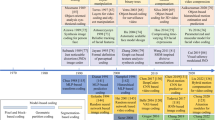Abstract
This paper presents a joint scene and signal modeling for the design of an adaptive quantization scheme applied to the wavelet coefficients in subband video coding applications. The joint modeling includes two integrated components: the scene modeling characterized by the neighborhood binding with Gibbs random field and the signal modeling characterized by the matching of the wavelet coefficient distribution. With this joint modeling, the quantization becomes adaptive to not only wavelet coefficient signal distribution but also the prominent image scene structures. The proposed quantization scheme based on the joint scene and signal modeling is accomplished through adaptive clustering with spatial neighborhood constraints. Such spatial constraint allows the quantization to shift its bit allocation, if necessary, to those perceptually more important coefficients so that the preservation of scene structure can be achieved. This joint modeling enables the quantization to reach beyond the limit of the traditional statistical signal modeling-based approaches which often lack scene adaptivity. Furthermore, the dynamically enforced spatial constraints of the Gibbs random field are able to overcome the shortcomings of the artificial block division which are usually the major source of distortion when the video is coded by block-based approaches at low bit rate. In addition, we introduce a cellular neural network architecture for the hardware implementation of this proposed adaptive quantization. We prove that this cellular neural network does converge to the desired steady state with the suggested update scheme. The adaptive quantization scheme based on the joint scene and signal modeling has been successfully applied to videoconferencing application and very favorable results have been obtained. We believe that this joint modeling-based video coding will have an impact on many other applications because it is able to simultaneously perform signal adaptive and scene adaptive quantization.
Similar content being viewed by others
References
G. Karlsson and M. Vetterli, “Three dimensional sub-band coding of video,” in Proc. International Conf. Acoustics, Speech and Signal Processing, pp. 1110–1113, 1988.
M. Antonini, M. Barlaud, P. Mathieu, and I. Daubechies, “Image coding using vector quantization in the wavelet transform domain,” in Proc. International Conf. Acoustics, Speech and Signal Processing, pp. 2297–2300, 1990.
R.H. Bamberger, “New subband decompositions and coders for image and video compression,” in Proc. International Conf. Acoustics, Speech and Signal Processing, San Francisco, CA, 1992, pp. III-217–220.
C. Podilchunk and A. Jacquin, “Subband video coding with a dynamic bit allocation and geometric vector quantization,” in Human Vision, Visual Processing, and Digital Display III, Boston, MA, 1992, Vol. SPIE 1666, pp. 241–252.
J. Hartung, “Architecture for the real-time implementation of three-dimensional subband video coding,” in Proc. International Conf. Acoustics, Speech and Signal Processing, San Francisco, CA, 1992, pp. III–225–228.
H. Gharavi, “Subband coding of video signals,” in Subband Image Coding, J.W. Woods (Ed.), pp. 229–272, Kluwer Academic Publishers, Boston, MA, 1991.
N. Mohsenian and N.M. Nasrabadi, “Subband coding of video using edge-based vector quantization technique for compression of the upper bands,” in Proc. International Conf. Acoustics, Speech and Signal Processing, San Francisco, CA, 1992, pp. III–233–236
M. Antonini, M. Barlaud, P. Mathieu, and I. Daubechies, “Image coding using wavelet transform,” IEEE Trans. Image Processing, Vol. 1, pp. 205–220, 1992.
D. Marr, Vision: A Computational Investigation into the Human Representation and Processing of Visual Information, Freeman, San Francisco, CA, 1982.
A.N. Netravali and B.G. Haskell, Digital Pictures: Representation, Compression, and Standards, 2nd edition, New York, NY, Plenum Press, 1995.
T. Pappas, “An adaptive clustering algorithm for image segmentation,” IEEE Trans. Signal Proc., Vol. 40, pp. 901–914, 1992.
J. Besag, “Spatial interaction and the statistical analysis of lattice system,” Journal of the Royal Statistical Society, Vol. 36, pp. 192–326, 1974.
A.S. Lewis and G. Knowles, “Image compression using the 2-D wavelet transform,” IEEE Trans. Image Processing, Vol. 1, pp. 244–250, 1992.
J. Luo, C.W. Chen, K.J. Parker, and T.S. Huang, “A scene adaptive and signal adaptive quantization for subband image and video compression using wavelets,” IEEE Trans. Circuit and System for Video Technology, Vol. 7, pp. 343–357, 1997.
C.W. Chen, Y.Q. Zhang, J. Luo, and K.J. Parker, “Medical image compression with structure-preserving adaptive quantization,” in '95, Taiwan, China, May 1995, pp. 982–993.
J. Luo, Z. Sun, C.W. Chen, and K.J. Parker, “Wavelet-based video coding for wireless communications,” in SPIE Conf. Wavelet Applications, Orlando, FL, April 1996, pp. 454–465.
J.J. Hopfield, “Neural network and physical systems with emergent collective computational abilities,” in National Acad. Sci., USA, Vol. 79, pp. 2554–2558, 1982.
J.J. Hopfield, “Neurons with graded response have collective computational properties like those of two state neurons,” in National Acad. Sci., USA, Vol. 81, pp. 3088–3092, 1984.
J.J. Hopfield and D.W. Tank, “Neural computation of decisions in optimizing problems,” Biological Cybern., Vol. 52, pp. 141– 152, 1985.
T. Kohonen, Self-Organization and Associative Memory, Spring-Verlag, Berlin, 1988.
D.E. Rumelhart, G.E. Hinton, and R.J. Williams, “Learning internal representations by error propagation,” in Parallel Distributed Processing, D.E. Rumelhart, J.L. McClelland (Eds.), and the PDP Research Group, Vol. 1, MIT Press, Cambridge, MA, 1986.
L.O. Chua and L. Yang, “Cellular neural networks: Applications,” IEEE Trans. Circuits and Systems, Vol. 35, pp. 1273– 1290, 1988.
J. Basak, B. Chanda, and D. Dutta Majumder, “On edge and line linking with connectionist models,” IEEE Trans. Syst. Man, Cybern., Vol. 24, pp. 413–428, 1994.
J. Basak, C.A. Murthy, S. Chaudhury, and D. Dutta Majumder, “A connectionist model for category perception: theory and implementation,” IEEE Trans. Neural Networks, Vol. 4, pp. 257– 269, 1993.
J. Luo, C.W. Chen, and K.J. Parker, “Volumetric medical image compression with three dimensional wavelet transform and octave zerotree coding,” in '96, Orlando, FL, March 1996, pp. 579–590.
Author information
Authors and Affiliations
Rights and permissions
About this article
Cite this article
Chen, C.W., Luo, J., Chen, L. et al. Joint Scene and Signal Modeling for Wavelet-Based Video Coding with Cellular Neural Network Architecture. The Journal of VLSI Signal Processing-Systems for Signal, Image, and Video Technology 17, 201–214 (1997). https://doi.org/10.1023/A:1007954923364
Published:
Issue Date:
DOI: https://doi.org/10.1023/A:1007954923364




